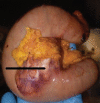A jejunal gastrointestinal stromal tumor with massive gastrointestinal hemorrhage treated by emergency surgery: A case report
- PMID: 36107510
- PMCID: PMC9439765
- DOI: 10.1097/MD.0000000000030098
A jejunal gastrointestinal stromal tumor with massive gastrointestinal hemorrhage treated by emergency surgery: A case report
Abstract
Background: A jejunal gastrointestinal stromal tumor (GIST) is a rare neoplasm of the gastrointestinal (GI) tract. Massive bleeding due to a jejunal GIST is a diagnostic and therapeutic challenge. It may be a life-threatening GIST complication that requires urgent intervention. Acute GI bleeding, which requires urgent surgical intervention, is a very rare clinical manifestation of GIST. A jejunal GIST with massive hemorrhage with coronavirus disease 2019 in a male patient in older age with many comorbidities has been not reported in the worldwide literature.
Methods: In this case report, we present an 80-year-old man who was admitted to surgery due to abdominal pain, melena, and hematochezia for several hours. An upper endoscopy and colonoscopy were inconclusive. A multidetector contrast-enhanced computed tomography (CT) of the abdominal and pelvic cavity showed concentric irregular thickening in the distal jejunum.The histopathological finding showed a GIST measuring 6 cm with a mitotic index 2/50 high power fields. The patient's hemodynamic condition deteriorated despite initial conservative treatment including a blood transfusion. Therefore, patient underwent the emergency surgery 24 hours after admission: partial jejunal resection with the tumor followed by primary end-to-end anastomosis.
Results: The mass was removed completely. There were no surgical complications in the postoperative course. On the first postoperative day, a severe acute respiratory syndrome coronavirus 2 polymerase chain reaction test was performed due to a persistent dry cough, which yielded a positive result. After 14 days, the patient died due to pneumonia and circulatory failure.
Conclusions: This case indicates that jejunal GIST can present as massive lower gastrointestinal bleeding and urgent surgery can successfully stop bleeding and save the patient's life. The CT scan was the most effective investigation to find the source of GI bleeding in this case. Therefore, we suggest performing CT in patients with acute massive lower gastrointestinal bleeding when the source of bleeding is not visible on endoscopy, and urgent surgical jejunal resection to stop life-threatening bleeding caused by a jejunal GIST.
Copyright © 2022 the Author(s). Published by Wolters Kluwer Health, Inc.
Conflict of interest statement
The authors have no funding and conflicts of interest to disclose.
Figures








References
-
- Qayed E, Dagar G, Nanchal RS. Lower gastrointestinal hemorrhage. Crit Care Clin. 2016;32:241–54. - PubMed
-
- Casali PG, Abecassis N, Aro HT, et al. ; ESMO Guidelines Committee and EURACAN. Gastrointestinal stromal tumours: ESMO-EURACAN clinical practice guidelines for diagnosis, treatment and follow-up. Ann Oncol. 2018;29(suppl 4):iv68–iv78. - PubMed
-
- Zemła P, Stelmach A, Jabłońska B, et al. . A retrospective study of postoperative outcomes in 98 patients diagnosed with gastrointestinal stromal tumor (GIST) of the upper, middle, and lower gastrointestinal tract between 2009 and 2019 at a single center in Poland. Med Sci Monit. 2021;27:e932809. - PMC - PubMed
-
- Rubin BP, Heinrich MC, Corless CL. Gastrointestinal stromal tumour. Lancet. 2007;369:1731–41. - PubMed
Publication types
MeSH terms
LinkOut - more resources
Full Text Sources
Medical

